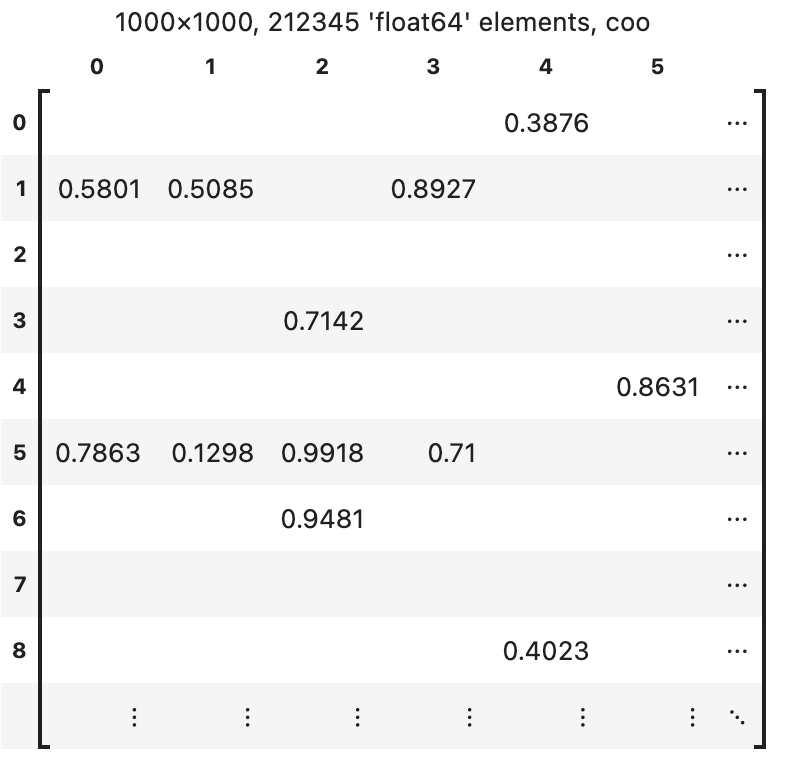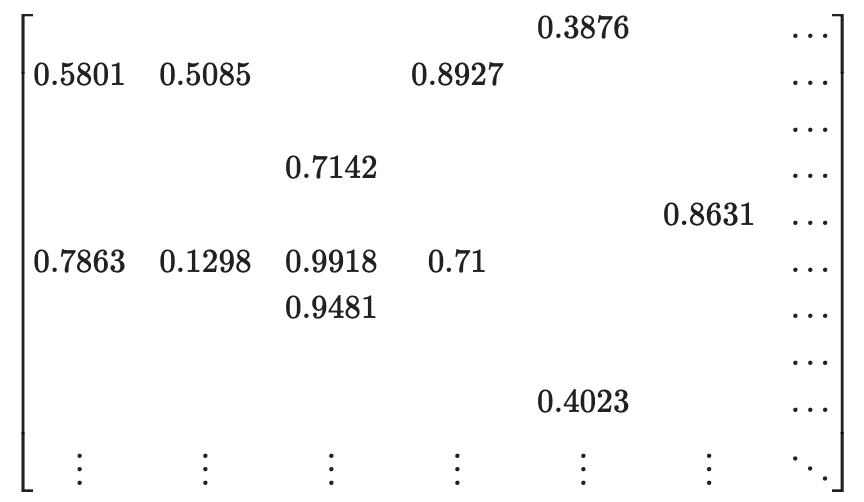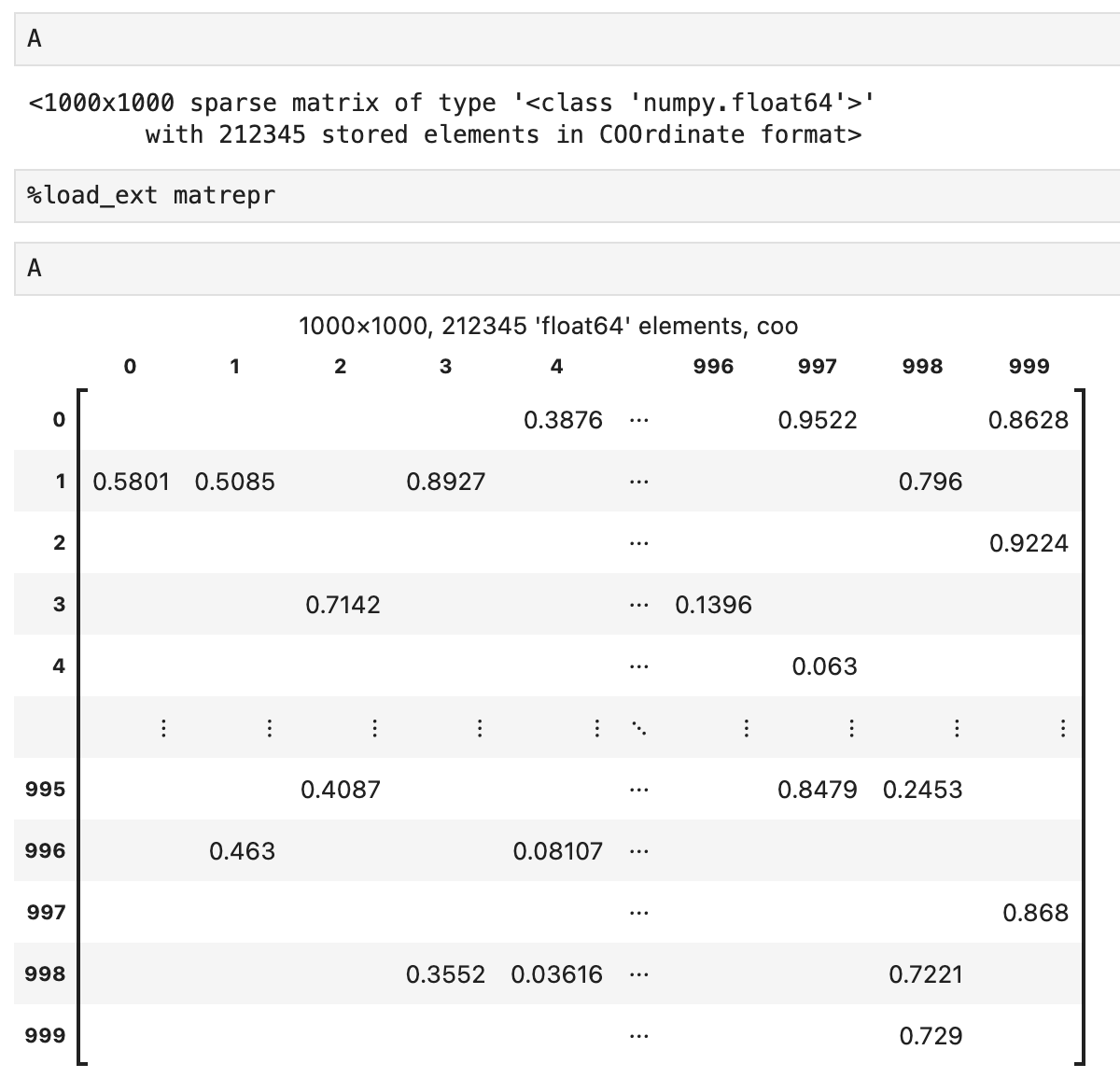Sparse matrix string, HTML, and LaTeX rendering with Jupyter integration.
Project description
MatRepr
pip install matrepr
Sparse matrix string, HTML, and LaTeX representation with Jupyter integration.
Supports:
- SciPy - sparse matrices and arrays like
csr_matrixandcoo_array - Python-graphblas -
gb.Matrixandgb.Vector(demo) - PyData/Sparse -
COO,DOK,GCXS(demo) - NumPy -
ndarray list,tuple, including multi-dimensional and jagged
Use MatRepr to turn this opaque string:
<1000x1000 sparse matrix of type '<class 'numpy.float64'>'
with 212345 stored elements in COOrdinate format>
To one of these:
String
1000×1000, 212345 'float64' elements, coo
0 1 2 3 4 5
┌ ┐
0 │ 0.3876 ... │
1 │ 0.5801 0.5085 0.8927 ... │
2 │ ... │
3 │ 0.7142 ... │
4 │ 0.8631 ... │
5 │ 0.7863 0.1298 0.9918 0.71 ... │
6 │ 0.9481 ... │
7 │ ... │
8 │ 0.4023 ... │
│ : : : : : : ... │
└ ┘
mprint(A), to_str() for the string, or simply A if using monkey patching as below.
HTML
mdisplay(A), or simply A if Jupyter integration enabled. Use to_html() for raw HTML string.
LaTeX
mdisplay(A, 'latex'), or simply A if LaTeX version of Jupyter integration enabled. Use to_latex() for raw LaTeX string.
Note: For Spy plots see MatSpy.
Quick Start
pip install matrepr
from matrepr import mdisplay
Methods:
to_str(A): FormatAas string.to_html(A): FormatAas an HTML table. Returns a string.to_latex(A): FormatAas a LaTeX matrix. Returns a string.mprint(A): printAas a string to stdout.mdisplay(A): Displays the output ofto_html,to_latex, orto_strin Jupyter.
Jupyter Integration
MatRepr can integrate with Jupyter's formatter
to format SciPy, GraphBLAS, and PyData/Sparse with MatRepr. Simply import matrepr.jupyter to register MatRepr's formatter
with Jupyter.
import matrepr.jupyter
If you prefer LaTeX:
import matrepr.jupyter_latex
Interactive Python: Monkey Patching __repr__
Unlike Jupyter, the interactive Python REPL does not have a nice way to register a formatter.
We can monkey patch a __repl__ method into supported matrix classes for a similar effect.
This is implemented in the matrepr.patch module. Simply import the patch you want:
import matrepr.patch.scipyimport matrepr.patch.graphblasimport matrepr.patch.sparse
Example:
>>> a = scipy.sparse.random(4, 4, density=0.5)
>>> a
<4x4 sparse matrix of type '<class 'numpy.float64'>'
with 8 stored elements in COOrdinate format>
>>> import matrepr.patch.scipy
>>> a
4×4, 8 'float64' elements, coo
0 1 2 3
┌ ┐
0 │ 0.4016 0.4412 │
1 │ 0.309 0.8055 │
2 │ 0.1982 │
3 │ 0.7438 0.6938 0.2215 │
└ ┘
Arguments
All methods take the same arguments. Apart from the matrix itself:
title: string label. IfTrue, then a matrix description is auto generated that contains matrix shape, number and type of nonzeros, etc.indices: Whether to show matrix indices.max_rows,max_rows: size of table. Matrices larger than this are truncated with ellipses.precision: floating-point precisionnum_after_dots: How many rows/columns to show from the end of the matrix if the entire matrix does not fit.
Overriding defaults
matrepr.params contains the default values for all arguments.
For example, to always disable the title, disable indices, and only show the top-left part of the matrix:
matrepr.params.title = False
matrepr.params.indices = False
matrepr.params.num_after_dots = 0
Edge Cases
MatRepr gracefully handles:
- multiple elements with the same coordinates (i.e. duplicates)
- nested matrices
- complex values
- string values (including multiline)
- LaTeX scientific notation as $
\times 10^{power}$
See demo-edgecases notebook for more.
How does it work?
Each package that MatRepr supports implements two classes:
Driver: Declares what types are supported and supplies an adapter.get_supported_types: This declares what types are supported, as strings to avoid unnecessary imports.adapt(A): Returns aMatrixAdapterfor a matrix that this driver supports.
MatrixAdapter. A common interface for extracting relevant matrix data. MatRepr supports three kinds, only one needs to be implemented:MatrixAdapterRow: is able to efficiently read a selected row.MatrixAdapterCol: is able to efficiently read a selected column.MatrixAdapterCoo: is able to extract a portion of the matrix as tuples.
See matrepr/adapters for details.
You may use matspy.register_driver to register a Driver for your own matrix class.
Project details
Release history Release notifications | RSS feed
Download files
Download the file for your platform. If you're not sure which to choose, learn more about installing packages.

















